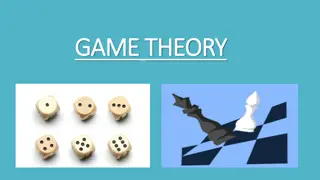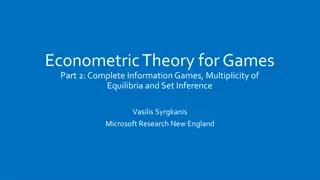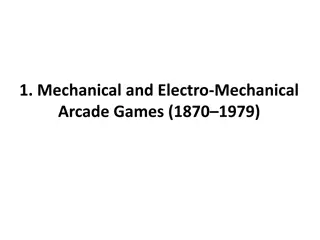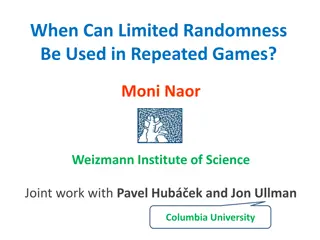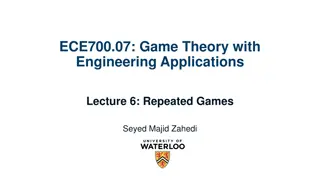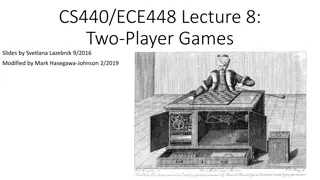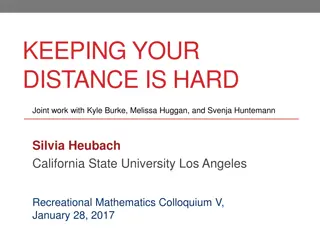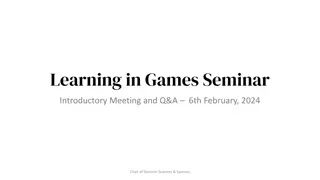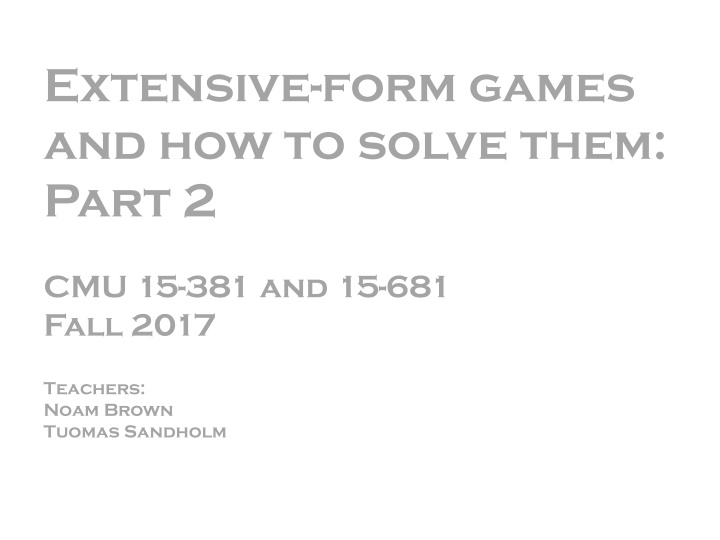
Solving Extensive Form Games: Strategies and Equilibria
Explore the concept of Nash equilibrium in game theory, learn how to identify dominated actions, and simplify two-player zero-sum games by removing dominant strategies. Discover how players can achieve optimal outcomes by making strategic decisions based on incentives and payoffs.
Download Presentation

Please find below an Image/Link to download the presentation.
The content on the website is provided AS IS for your information and personal use only. It may not be sold, licensed, or shared on other websites without obtaining consent from the author. If you encounter any issues during the download, it is possible that the publisher has removed the file from their server.
You are allowed to download the files provided on this website for personal or commercial use, subject to the condition that they are used lawfully. All files are the property of their respective owners.
The content on the website is provided AS IS for your information and personal use only. It may not be sold, licensed, or shared on other websites without obtaining consent from the author.
E N D
Presentation Transcript
Extensive-form games and how to solve them: Part 2 CMU 15-381 and 15-681 Fall 2017 Teachers: Noam Brown Tuomas Sandholm
Removing Dominated Actions If an action is never better than some linear combination of other actions, then it is dominated Strictly dominated: The action is always worse than some other (mixed) strategy Weakly dominated: The action is never better than some other (mixed) strategy Two-player zero-sum games can be simplified by iteratively removing all dominated actions (in general-sum, can only remove strictly dominated) Player 2 Left Center Right Up -5 -4 1 Player 1 Middle -4 0 0 Down 3 4 -1
Removing Dominated Actions 50% Up, 50% Down: Thus, Middle is a weakly dominated action [-1, 0, 0] [-4, 0, 0] Middle: Player 2 Left Center Right Up -5 -4 1 Player 1 Middle -4 0 0 Down 3 4 -1
Removing Dominated Actions 50% Up, 50% Down: Thus, Middle is a weakly dominated action [-1, 0, 0] [-4, 0, 0] Middle: Player 2 Left Center Right Up -5 -4 1 Player 1 Middle -4 0 0 Down 3 4 -1
Nash equilibrium Standard Nash equilibrium: Each player has no incentive to deviate In other words: No agent can gain utility by switching to another strategy In any Nash equilibrium, if a player has positive probability on two different actions, then they must result in the same expected value If they didn t, it wouldn t be a Nash equilibrium! (Player could improve by switching to the higher-EV action) -Nash equilibrium: Each player has only incentive to deviate In other words: No agent can gain more than utility by switching to another strategy
Nash equilibrium ? ?? = 0.2 5 + 0.8 1 = 1 + 0.8 = 0.2 ? ???? = 0.2 3 + 0.8 1 = 0.6 0.8 = 0.2 ? ???? = 0.4 5 + 0.6 3 = 2 + 1.8 = 0.2 ? ?????? = 0.4 4 + 0.6 4 = 0 ? ????? = 0.4 1 + 0.6 1 = 0.2 Player 2 .2 .8 Left -5 3 Center -4 4 Right 1 -1 Player 1 Up .4 Down .6
Nash equilibria for two-player zero-sum games Any linear combination of two Nash equilibria is another Nash equilibrium ,?2 is a Nash equilibrium, If ?1,?2 is a Nash equilibrium and ?1 then ?1,?2 is a Nash equilibrium A player gets the same expected value from every Nash equilibrium Nash equilibria can be computed in polynomial time
Solving two-player zero-sum extensive-form games
Plan for next part of the presentation We will introduce counterfactual regret minimization (CFR)-based equilibrium finding in two-player zero-sum games Most common algorithm Relatively easy to understand and implement We start from first principles and proceed step by step to the most advanced algorithms in this family Used to be best in practice, but now there is a gradient-based algorithm that is better in practice also [Kroer et al. EC-17] But that is much more difficult to understand
Regret Minimization Repeat on each iteration ? ?: Nature picks a hidden payoff ??(?) for each action in [-10, 10]. Payoffs might not be drawn from a pre-defined distribution, could be non-stationary We pick a strategy (probability distribution over actions) ??= [???1,???2,???3] We receive a payoff ??= ?(??? ??? ) Goal: Do about as well as the best single action in hindsight Define Regret??? = ? ???? ? ??? and ??= max We want ?? ? 0 as ? Note: We are not trying to do as well as the best sequence of actions, just the best single action ??? ?
Convergence to Nash Equilibrium Folk Theorem: In a two-player zero-sum game, if ?? both players, then their average strategies over the ? iterations form a 2 -Nash equilibrium. ? ? for Recall that in two-player zero-sum games, every Nash equilibrium results in the same value.
Regret Minimization: Example Iteration 1 Payoff: 10 Payoff: 0 Payoff: 10 Action A Action B Action C Total Payoff: 0 Total Payoff: 0 Total Payoff: 0 Our Total Payoff: 0 Difference between our payoff and the best lever Maximum Regret: 0
Regret Minimization: Example Iteration 1 Payoff: 10 Payoff: 0 Payoff: 10 Action A Action B Action C Total Payoff: 0 Total Payoff: 10 Total Payoff: 10 Our Total Payoff: 0 Maximum Regret: 10
Regret Minimization: Example Iteration 2 1/3 1/3 1/3 Payoff: 10 Payoff: -10 Payoff: -10 Action A Action B Action C Total Payoff: 0 Total Payoff: 10 Total Payoff: 10 Our Total Payoff: 0 Maximum Regret: 10
Regret Minimization: Example Iteration 2 1/3 1/3 1/3 Payoff: 10 Payoff: -10 Payoff: -10 Action A Action B Action C Total Payoff: -10 Total Payoff: 20 Total Payoff: 0 Our Total Payoff: 31 3 Maximum Regret: 231 3
Regret Matching Idea: Pick actions in proportion to the amount of positive regret on the actions Let ??? = ?=0 ??(?) ?? ??+1? = ? ?max{??? ,0} Start with a uniform random strategy Theorem: If we pick actions (levers) according to ? max{??? ,0} Range of payoffs (20 in our example) ??? ? |?| Regret Matching (RM) then max ? ? ? [Hart and Mas-Colell 2000] Number of actions
Regret Matching Step 1: Set current strategy based on regrets Strategy Sum: 0.0 0.0 Iteration 0 Regret Sum: 0.0 0.0 Strategy Sum: Regret Sum: Left 50% Right 50% 0.0 0.0 Up 50% 1 0 0.0 0.0 Down 50% 0 2
Regret Matching Step 2: Update average strategy tracker Strategy Sum: 0.5 0.5 Iteration 0 Regret Sum: 0.0 0.0 Strategy Sum: Regret Sum: Left 50% Right 50% 0.5 0.0 Up 50% 1 0 0.5 0.0 Down 50% 0 2
Regret Matching Step 3: Calculate total EV Strategy Sum: 0.5 0.5 Iteration 0 Regret Sum: 0.0 0.0 Strategy Sum: Regret Sum: Left 50% Right 50% 0.5 0.0 Up 50% 1 0 0.5 0.0 Down 50% 0 2 Expected Value: 0.75
Regret Matching Step 4: Calculate EV for each action Strategy Sum: 0.5 0.5 Iteration 0 Regret Sum: 0.0 0.0 Strategy Sum: Regret Sum: Left 50% Right 50% 0.5 0.0 Up 50% 1 0 0.5 0.0 Down 50% 0 2 Expected Value: 0.75 Up: 0.5 Down: 1 Added Regret: 0.5 0.75 = -0.25 Added Regret: 1.0 0.75 = 0.25
Regret Matching Step 5: Update regret for each action Strategy Sum: 0.5 0.5 Iteration 0 Regret Sum: 0.25 -0.25 Strategy Sum: Regret Sum: Left 50% Right 50% 0.5 -0.25 Up 50% 1 0 0.5 0.25 Down 50% 0 2 Expected Value: 0.75 Up: 0.5 Down: 1 Added Regret: 0.5 0.75 = -0.25 Added Regret: 1.0 0.75 = 0.25
Regret Matching Step 1: Set current strategy based on regrets Strategy Sum: 0.5 0.5 Iteration 1 Regret Sum: 0.25 -0.25 Strategy Sum: Regret Sum: Left 100% Right 0% 0.5 -0.25 Up 0% 1 0 0.5 0.25 Down 100% 0 2
Regret Matching Step 2: Update average strategy tracker Strategy Sum: 1.5 0.5 Iteration 1 Regret Sum: 0.25 -0.25 Strategy Sum: Regret Sum: Left 100% Right 0% 0.5 -0.25 Up 0% 1 0 1.5 0.25 Down 100% 0 2
Regret Matching Step 3: Calculate total EV Strategy Sum: 1.5 0.5 Iteration 1 Regret Sum: 0.25 -0.25 Strategy Sum: Regret Sum: Left 100% Right 0% 0.5 -0.25 Up 0% 1 0 1.5 0.25 Down 100% 0 2 Expected Value: 0.0
Regret Matching Step 4: Calculate EV for each action Strategy Sum: 1.5 0.5 Iteration 1 Regret Sum: 0.25 -0.25 Strategy Sum: Regret Sum: Left 100% Right 0% 0.5 -0.25 Up 0% 1 0 1.5 0.25 Down 100% 0 2 Expected Value: 0.0 Up: 1.0 Down: 0.0 Added Regret: 1.0 0.0 = 1 Added Regret: 0.0 0.0 = 0.0
Regret Matching Step 5: Update regret for each action Strategy Sum: 1.5 0.5 Iteration 1 Regret Sum: 0.25 1.75 Strategy Sum: Regret Sum: Left 100% Right 0% 0.5 0.75 Up 0% 1 0 1.5 0.25 Down 100% 0 2 Expected Value: 0.0 Up: 1.0 Down: 0.0 Added Regret: 1.0 0.0 = 1 Added Regret: 0.0 0.0 = 0.0
Counterfactual Regret Minimization (CFR) [Zinkevich et al. NIPS-2007] Applies regret matching to minimize regret independently in each information set (infoset) of an extensive-form game. In CFR, an infoset belonging to player ? weighs each iteration in proportion to the probability the infoset was reached if player ?had tried to reach the infoset.
Counterfactual Regret Minimization (CFR) [Zinkevich et al. NIPS-2007] P1 P2 P2 P1 P1 P1 P1 1 -1 -1 -1 -1 1 1 1
Counterfactual Regret Minimization (CFR) [Zinkevich et al. NIPS-2007] ? P1 ? ? for this history is 0.1 0.5 0.5 P2 ?? is the probability node is reached according to both players strategies. ? ? reached if player ? tried to get there. ? is the probability is 0.1 0.9 Maintain regret vector for actions in each infoset ?. On iteration ? + 1, actions chosen with probability P1 P1 ??? 0,???,? ? ??? 0,???,? ?? ,? ??(?) is the reward for ? ??+1?,? = ?? = ?,? ?? ? ? ?? infoset ?, weighted by ? ? 1 -1 -1 1 ??,? = ? ?? ?? ? ?? ?? ?? infoset ? is regret for action ? in Theorem: regret for the whole game is bounded by regret summed over all infosets. ?? ? ??? ?(?)
Counterfactual Regret Minimization (CFR) [Zinkevich et al. NIPS-2007] P1 0.5 0.5 P2 0.1 0.9 Iteration 1: Regret is 0,0 , so pick uniform random probability. That is, p1? = 0.5,0.5 P1 P1 0.5 0.5 0.5 0.5 1 -1 -1 1
Counterfactual Regret Minimization (CFR) [Zinkevich et al. NIPS-2007] P1 0.5 0.5 P2 0.1 0.9 Iteration 1: Regret is 0,0 , so pick uniform random probability. That is, p1? = 0.5,0.5 P1 P1 1? = 0.1 0.5 ( 1) + 0.5 1 + ?? 0.5 0.5 0.5 0.5 1 -1 -1 1
Counterfactual Regret Minimization (CFR) [Zinkevich et al. NIPS-2007] P1 0.5 0.5 P2 0.1 0.9 Iteration 1: Regret is 0,0 , so pick uniform random probability. That is, p1? = 0.5,0.5 P1 P1 1? = 0.1 0.5 ( 1) + 0.5 1 + ?? 0.5 0.5 0.5 0.9 0.5 1 + 0.5 1 = 0 0.5 1 -1 -1 1
Counterfactual Regret Minimization (CFR) [Zinkevich et al. NIPS-2007] P1 0.5 0.5 P2 0.1 0.9 Iteration 1: Regret is 0,0 , so pick uniform random probability. That is, p1? = 0.5,0.5 P1 P1 1? = 0.1 0.5 ( 1) + 0.5 1 + ?? 0.5 0.5 0.5 0.9 0.5 1 + 0.5 1 = 0 0.5 1? ???? = 0.1 1 + 0.9 1 = 0.8 ?? 1 -1 -1 1
Counterfactual Regret Minimization (CFR) [Zinkevich et al. NIPS-2007] P1 0.5 0.5 P2 0.1 0.9 Iteration 1: Regret is 0,0 , so pick uniform random probability. That is, p1? = 0.5,0.5 P1 P1 1? = 0.1 0.5 ( 1) + 0.5 1 + ?? 0.5 0.5 0.5 0.9 0.5 1 + 0.5 1 = 0 0.5 1? ???? = 0.1 1 + 0.9 1 = 0.8 ?? 1 -1 -1 1 1? ??? ? = 0.1 1 + 0.9 1 = 0.8 ??
Counterfactual Regret Minimization (CFR) [Zinkevich et al. NIPS-2007] P1 0.5 0.5 P2 0.1 0.9 Iteration 1: Regret is 0,0 , so pick uniform random probability. That is, p1? = 0.5,0.5 P1 P1 1? = 0.1 0.5 ( 1) + 0.5 1 + ?? 0.5 0.5 0.5 0.9 0.5 1 + 0.5 1 = 0 0.5 1? ???? = 0.1 1 + 0.9 1 = 0.8 ?? 1 -1 -1 1 1? ??? ? = 0.1 1 + 0.9 1 = 0.8 ?? Iteration 2: Regret is 0.8, 0.8 , so pick probability p2? = 1.0,0.0
CFR Pseudocode function CFR(node, reach[2]) //Call CFR(Initial, {1, 1}) at the start of each iteration, for as many iterations as you wish. if (node is terminal) then return {node.value[0] reach[1], node.value[1] reach[0]} else ev[2] = 0 if (node is chance) then for each action in node: new_reach[2] = {reach[0] prob[action], reach[1] prob[action]} ev += CFR(node.do_action(action), new_reach) else action_ev[number of actions][2] = 0 player = node.whose_turn, opponent = 1 player set probabilities for actions in proportion to positive regret (if it is the first time this information set is encountered this iteration) for each action in node: node.stored_strategy[action] += reach[player] prob[action] //update the average strat (normalize at the end) new_reach[player] = reach[player] prob[action], new_reach[opponent] = reach[opponent] action_ev[action] = CFR(node.do_action(action), new_reach) //get the value for taking this action ev[player] += prob[action] action_ev[action][player] ev[opponent] += action_ev[opponent] for each action in node: node.regret[action] += (action_ev[action][player] ev[player]) //update the regret for each action return ev
Alternating-Updates CFR Pseudocode function CFR(node, reach, p) //Call CFR(Initial, 1, p) at the start of each traversal, where p alternates between P1 and P2. if (node is terminal) then return node.value[p] reach else ev = 0 if (node is chance) then for each action in node: ev += CFR(node.do_action(action), reach * prob[action], p) else set probabilities for actions in proportion to positive regret (if it is the first time this information set is encountered this traversal) if (node.whose_turn == p): for each action in node: action_ev[action] = CFR(node.do_action(action), reach, p) //get the value for taking this action ev += prob[action] action_ev[action] for each action in node: node.regret[action] += (action_ev[action] ev) //update the regret for each action else for each action in node: node.stored_strategy[action] += reach prob[action] //update the average strat (normalize at the end) ev += CFR(node.do_action(action), reach * prob[action], p) return ev
CFR+ [Tammelin 2014] Simple modification of CFR: After each iteration, any regrets below zero are set to zero Weigh strategy on iteration ? by weight ?. That is, ??= ?(? ?? Tends to do better when using Alternating Updates Same theoretical convergence rate, but way better in practice ?)/ ??
PureCFR P1 Regrets = [0,0] Strategy Sum = [0,0,0] Strategy Sum = [0,1,0] P2 Regrets = [0,0,0] P1
PureCFR P1 Regrets = [0,0] P2 Regrets = [0,0,0] Regrets = [0, 50,50] P1 Hypothetical Reward = $0
PureCFR P1 Regrets = [0,0] Regrets = [0, 550] Regrets = [0, 0] Regrets = [0, 600] P1 P2 Reward = -$500 Regrets = [0, 50,50] P1 Hypothetical Reward = $0
PureCFR Pseudocode function PureCFR(node, player) //Call PureCFR(Init, P) at the start of each iteration, where P switches between 0 and 1 if (node is terminal) then return node.value[player] else if (node is chance) then sample action a from chance distribution return PureCFR(node.do_action(a), player) else if (node.whose_turn != player) then set probabilities for actions in proportion to positive regret: ? ? max{0,? ?,? } sample action a node.stored_strategy[a] += 1 // update the average strategy (normalize at the end) return PureCFR(node.do_action(a), player) else set probabilities for actions in proportion to positive regret: ? ? max{0,? ?,? } sample action ? for each action in node: action_value[action] = PureCFR(node.do_action(action), player) // get the value for taking this action for each action in node: node.regret[action] += action_value[action] action_value[? ] // update the regret return action_value[? ]
Monte Carlo CFR (MCCFR) [Lanctot et al. NIPS-2009] Identical to PureCFR except rather than the current player sampling a single action, the player calculates an expected value over all actions PureCFR: set probabilities for actions in proportion to positive regret: ? ? max{0,? ?,? } sample action ? for each action in node: action_value[action] = PureCFR(node.do_action(action), player) // get the value for taking this action for each action in node: node.regret[action] += action_value[action] action_value[? ] // update the regret return action_value[? ] MCCFR: set probabilities for actions in proportion to positive regret: ? ? max{0,? ?,? } ev = 0 for each action in node: action_value[action] = PureCFR(node.do_action(action), player) // get the value for taking this action ev += p(action) * action_value[action] for each action in node: node.regret[action] += action_value[action] ev // update the regret return ev
Poker Recognized challenge problem in game theory and AI [Nash 1950] [Kuhn 1950] [Newman 1959] [Waterman 1970] [Zadeh 1977] [Caro 1984] [Pfeffer & Koller 1995] [Billings et al. 1998] [Schaeffer et al. 1999] [Shi & Littman 2001] [Billings et al. 2003] Tremendous progress in the last 13 years Rhode Island Hold em solved (109 nodes) [Gilpin & Sandholm 2005] Annual Computer Poker Competition started in 2006 Limit Texas Hold em near-optimally solved (1013 decisions) [Bowling et al. 2015]
Heads-up no-limit Texas holdem Has become the main benchmark and challenge problem in AI for imperfect-information games 10161 situations Mostly played on the Internet Also in World Series of Poker, NBC Heads-Up Championship, etc. Featured in Casino Royale and Rounders Purest form of poker No prior AI has beat top humans
Brains vs AI Rematch Libratus (= our AI) against four of the best heads-up no- limit Texas Hold em specialist pros 120,000 hands over 20 days in January 2017 $200,000 divided among the pros based on performance Conservative experiment design
Final result Libratus beat the top humans in this game by a lot 147 mbb/hand Statistical significance 99.98%, i.e., 0.0002 Each human lost to Libratus Image result for brains vs ai
2012 2017





